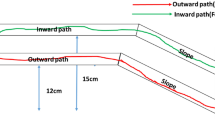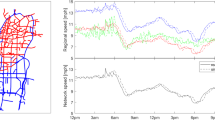Abstract
Efficient transportation, a hot topic in nonlinear science1, is essential for modern societies and the survival of biological species. Biological evolution has generated a rich variety of successful solutions2, which have inspired engineers to design optimized artificial systems3,4. Foraging ants, for example, form attractive trails that support the exploitation of initially unknown food sources in almost the minimum possible time5,6. However, can this strategy cope with bottleneck situations, when interactions cause delays that reduce the overall flow? Here, we present an experimental study of ants confronted with two alternative routes. We find that pheromone-based attraction generates one trail at low densities, whereas at a high level of crowding, another trail is established before traffic volume is affected, which guarantees that an optimal rate of food return is maintained. This bifurcation phenomenon is explained by a nonlinear modelling approach. Surprisingly, the underlying mechanism is based on inhibitory interactions. It points to capacity reserves, a limitation of the density-induced speed reduction, and a sufficient pheromone concentration for reliable trail perception. The balancing mechanism between cohesive and dispersive forces appears to be generic in natural, urban and transportation systems.
This is a preview of subscription content, access via your institution
Access options
Subscribe to this journal
Receive 51 print issues and online access
$199.00 per year
only $3.90 per issue
Buy this article
- Purchase on Springer Link
- Instant access to full article PDF
Prices may be subject to local taxes which are calculated during checkout




Similar content being viewed by others
References
Helbing, D. Traffic and related self-driven many-particle systems. Rev. Mod. Phys. 73, 1067–1141 (2001)
Camazine, S., et al. Self-organized Biological Systems (Princeton Univ. Press, Princeton, 2001)
Bonabeau, E., Dorigo, M. & Theraulaz, G. Inspiration for optimization from social insect behaviour. Nature 406, 39–42 (2000)
Bonabeau, E., Dorigo, M. & Theraulaz, G. Swarm Intelligence: From Natural to Artificial Systems (Oxford Univ. Press, New York, 1999)
Burd, M. & Aranwela, N. Head-on encounter rates and walking speed of foragers in leaf-cutting ant traffic. Insectes Soc. 50, 3–8 (2003)
Couzin, I. D. & Franks, N. R. Self-organized lane formation and optimized traffic flow in army ants. Proc. R. Soc. Lond. B 270, 139–146 (2003)
Parrish, J. K. & Hamner, W. K. Animal Groups in Three Dimensions (Cambridge Univ. Press, Cambridge, UK, 1997)
Krause, J. & Ruxton, D. Living in Groups (Oxford Univ. Press, Oxford, UK, 2002)
Galef, B. G. Jr & Buckley, L. L. Using foraging trails by Norway rats. Anim. Behav. 51, 765–771 (1996)
Fitzgerald, T. D. The Tent Caterpillars (Cornell Univ. Press, Ithaca, NY, 1995)
Erlandson, J. & Kostylev, V. Trail following, speed and fractal dimension of movement in a marine prosobranch, Littorina littorea, during a mating and a non-mating season. Mar. Biol. 122, 87–94 (1995)
Traniello, J. F. A. & Robson, S. K. in Chemical Ecology of Insects (eds Cardé, R. T. & Bell, W.) 241–286 (Chapman & Hall, New York, 1995)
Miura, T. & Matusmoto, T. Open-air litter foraging in the nasute termite Longipeditermes longipes (Isoptera: Termitidae). J. Insect Behav. 11, 179–189 (1998)
Helbing, D., Keltsch, J. & Molnár, P. Modelling the evolution of human trail systems. Nature 388, 47–50 (1997)
Edelstein-Keshet, L. W., Ermentrout, J. & Bard, G. Trail following in ants: individual properties determine population behaviour. Behav. Ecol. Sociobiol. 36, 119–133 (1995)
Schweitzer, F. Brownian Agents and Active Particles. Collective Dynamics in the Natural and Social Sciences (Springer, Berlin, 2003)
Wilson, E. O. Chemical communication among workers of the fire ant Solenopsis saevissima (Fr. Smith). 1. The organization of mass-foraging. Anim. Behav. 10, 134–147 (1962)
Hölldobler, B. & Wilson, E. O. The Ants 265–279 (The Belknap Press of Harvard Univ. Press, Cambridge, MA, 1990)
Beckers, R., Deneubourg, J. L. & Goss, S. Trails and U-turns in the selection of a path by the ant Lasius niger. J. Theor. Biol. 159, 397–415 (1992)
Goss, S., Aron, S., Deneubourg, J. L. & Pasteels, J. M. Self-organized shortcuts in the Argentine ant. Naturwissenschaften 76, 579–581 (1989)
Pasteels, J. M., Deneubourg, J. L. & Goss, S. in From Individual to Collective Behaviour in Social Insects (eds Pasteels, J. M. & Deneubourg, J. L.) Experientia suppl. Vol. 54, 155–175 (Birkhäuser, Basel, 1987)
Helbing, D. & Platkowski, T. Drift- or fluctuation-induced ordering and self-organization in driven many-particle systems. Europhys. Lett. 60, 227–233 (2002)
Burd, M. et al. Traffic dynamics of the leaf-cutting ant Atta cephalotes. Am. Nat. 159, 283–293 (2002)
Calenbuhr, V. et al. A model for osmotropotactic orientation. II. J. Theor. Biol. 158, 395–407 (1992)
Feener, D. H. & Moss, K. A. G. Defense against parasites by hitchhikers in leaf-cutting ants: a quantitative assessment. Behav. Ecol. Sociobiol. 49, 348–356 (1990)
Fretwell, S. D. & Lucas, H. L. On territorial behavior and other factors influencing habitat distribution in birds. I. Theoretical development. Acta Biotheor. 19, 16–36 (1970)
O'Toole, D. V., Robinson, P. A. & Myerscough, M. R. Self-organized criticality in termite architecture: a role for crowding in ensuring ordered nest expansion. J. Theor. Biol. 198, 305–327 (1999)
Fujita, M., Krugman, P. & Venables, A. The Spatial Economy–Cities, Regions, and International Trade (MIT Press, Cambridge, MA, 1999)
Acknowledgements
We thank G. Theraulaz and all the members of his team ‘Ethology and modelization of collective behaviours’ for discussions and comments on the manuscript. We also thank A. Schadschneider for discussions.
Author information
Authors and Affiliations
Corresponding author
Ethics declarations
Competing interests
The authors declare that they have no competing financial interests.
Rights and permissions
About this article
Cite this article
Dussutour, A., Fourcassié, V., Helbing, D. et al. Optimal traffic organization in ants under crowded conditions. Nature 428, 70–73 (2004). https://doi.org/10.1038/nature02345
Received:
Accepted:
Issue Date:
DOI: https://doi.org/10.1038/nature02345
This article is cited by
-
Spatiotemporal dynamics of traffic bottlenecks yields an early signal of heavy congestions
Nature Communications (2023)
-
Modelling flocks of birds and colonies of ants from the bottom up
International Journal on Software Tools for Technology Transfer (2023)
-
How host diet impact the life of termitophiles: insights from the Corotoca–Constrictotermes cyphergaster relationship
Insectes Sociaux (2023)
-
Ant Lasius niger joining one-way trails go against the flow
Scientific Reports (2022)
-
Honeybee communication during collective defence is shaped by predation
BMC Biology (2021)
Comments
By submitting a comment you agree to abide by our Terms and Community Guidelines. If you find something abusive or that does not comply with our terms or guidelines please flag it as inappropriate.



